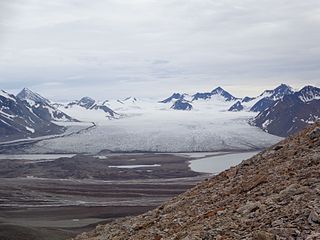Related Research Articles

Oscar II Land is the land area between Isfjorden and Kongsfjorden on Spitsbergen, Svalbard. The 30 km (19 mi) long glacier Sveabreen divides Oscar II Land from James I Land.

James I Land is a land area on the northwestern part of Spitsbergen, Svalbard. It is named after King James I of England and Scotland. The 30 kilometer long glacier Sveabreen divides James I Land from Oscar II Land.
Hinlopenbreen is a glacier stream in Spitsbergen, Svalbard. The glacier debouches into Vaigattbogen in Hinlopen Strait. The glacier has a length of about 70 km, and drains an area of about 1,250 km2 (480 sq mi).
Barentsjøkulen is a glacier on Barentsøya, Svalbard. The glacier covers an area of about 571 km2 (220 sq mi). It is named after the Barents Island, which again is named after Dutch explorer Willem Barentsz. Barents Island is on the Barents Sea.
St. Jonsfjorden is a fjord in Oscar II Land at Spitsbergen, Svalbard. It has a length of 21 kilometer, and opens westwards into the strait of Forlandsundet. Several glaciers debouche into the fjord, including Gaffelbreen and Konowbreen from the north, a merge of Osbornebreen, Devikbreen, Vintervegen, Paulbreen and Bukkebreen at the bottom, and Vegardbreen, Charlesbreen and Bullbreen from the south.
Osbornebreen is a glacier in Oscar II Land at Spitsbergen, Svalbard, Norway. It has a length of 21 kilometers, merges with the glaciers Devikbreen, Klampebreen and Vintervegen, and debouches into St. Jonsfjorden. The mountain ridge Goldschmidtfjella forms a six kilometer long nunatak in the glacier.
Charlesbreen is a glacier in Oscar II Land at Spitsbergen, Svalbard. It is located between Gunnar Knudsenfjella and Vegardfjella, and debouches into St. Jonsfjorden from the south side. The length of the glacier is ten kilometers. The glacier is named after Charles Robertson.
Devikfjellet is a mountain in Oscar II Land at Spitsbergen, Svalbard. It is located between the glaciers Osbornebreen and Devikbreen, northeast of the head of St. Jonsfjorden, and has an altitude of 860 meters. The mountain is named after physicist Olaf Devik. Nearby mountains are Krymlefjellet to the north and Klampen to the south.
Vintervegen is a glacier in Oscar II Land at Spitsbergen, Svalbard. It has a length of about 7.5 kilometers (4.7 mi). The glacier borders to the mountain of Klampen, merges with Osbornebreen and other glaciers, and the merged glacier stream debouches into the head of St. Jonsfjorden.

Sveabreen is a glacier between Oscar II Land and James I Land at Spitsbergen, Svalbard. It has a length of 30 kilometers (19 mi), stretching from Kongsvegpasset at an altitude about 750 meters (2,460 ft), and debouching into Nordfjorden.
Freemanbreen is a glacier on Barentsøya, Svalbard. It is an offshoot of Barentsjøkulen, reaching down to the sea in the southern direction, into Freeman Strait. The glacier is named after British Alderman Ralph Freeman. The mountain of Buklerimen separates Freemanbreen from the glacier of Hübnerbreen.
Gestriklandkammen is a mountain range in Oscar II Land at Spitsbergen, Svalbard. It has a length of about eleven kilometers and is located between the glaciers of Borebreen and Nansenbreen. It is named after the Swedish district of Gästrikland. Among the mountains in the range are Skonrokken, Kavringen, Vesleskrømtet, Kamhøgda and Krymleskuten.
Uvêrsbreen is a glacier in Oscar II Land at Spitsbergen, Svalbard. It has a length of about 25 kilometers. The glacier debouches into Engelskbukta, after merging with Comfortlessbreen.

Comfortlessbreen is a glacier in Oscar II Land at Spitsbergen, Svalbard. It has a length of about fourteen kilometers, and a maximum width of three kilometers. The glacier debouches into Engelskbukta, after a merge with Uvêrsbreen. Comfortlessbreen is separated from Uvêrsbreen by the mountain range of Trondheimfjella.
Vittenburgfjella is a mountain range in Oscar II Land at Spitsbergen, Svalbard. It is located at the eastern side of St. Jonsfjorden, surrounding the glacier of Paulbreen, and its highest peak is 895 m.a.s.l. The mountain range is named after Russian paleontologist Paul Vittenburg.
Aavatsmarkbreen is a glacier in Oscar II Land at Spitsbergen, Svalbard. It is named after politician and military officer Ivar Aavatsmark. The glacier debouches into Forlandsundet, in the bay of Hornbækbukta. At the southern side of the glacier, between Aavatsmarkbreen and Kaffiøyra, is the mountain range of Prins Heinrichfjella.
Dahlbreen is a glacier in Oscar II Land at Spitsbergen, Svalbard. It is named after whaler Thor Dahl. The glacier has a length of about fifteen kilometers, extending from Løvenskioldfonna to Forlandsundet. Among its tributary glaciers are Ujamnbreen, Bærumbreen and Fjelgbreen. Retreatment of the glacier has formed the bay of Dahlbrebukta.
Løvliebreen is a glacier in Oscar II Land at Spitsbergen, Svalbard. It has a length of about five kilometers, and is located between the mountain ranges of Gunnar Knudsenfjella and Holmesletfjella. The glacier debouches northwards towards St. Jonsfjorden. It is named after Norwegian businessperson Andreas Løvlie along with the nearby mountain of Løvliefjellet.
Huldrebreen is a glacier in Oscar II Land at Spitsbergen, Svalbard. It is surrounded by the mountains of Huldrehatten, Huldrefjellet and Bytingen, west in the mountainous district of Trollheimen. Huldrebreen and Austgötabreen are located north of the glacier complex of Eidembreen. The glacier is named after Hulder in Scandinavian folklore.
Hübnerbreen is a glacier at Barentsøya, Svalbard. It is located at the eastern part of the island, and is named after mining engineer and Arctic explorer Adolf Hübner. The mountain of Buklerimen separates Hübnerbreen from Freemanbreen. The coastal plain of Ritterflya, at the east coast of Barentsøya, is formed by deposits from Hübnerbreen and the nearby Reymondbreen.
References
- ↑ "Paulbreen (Svalbard)". Norwegian Polar Institute. Archived from the original on 10 June 2015. Retrieved 19 November 2013.
- ↑ "Vittenburgfjella (Svalbard)". Norwegian Polar Institute. Archived from the original on 10 June 2015. Retrieved 19 November 2013.
78°34′N13°26′E / 78.56°N 13.43°E